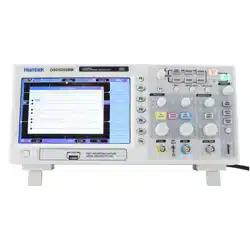Loading ...
Loading ...
Loading ...

Main Feature Description
DS O5000 Series Digital Storage Oscilloscope User Manual
10
show s the frequency relationship between the signal and the AC commercial power .
Trigger
Trigger
Trigger
Trigger Type:
Type:
Type:
Type: The oscilloscope has six types of triggers: Edge, Video, Pulse Width, Slope,
Overtime and Swap.
Edge
Edge
Edge
Edge Trigger
Trigger
Trigger
Trigger uses the analog or digital test circuits for triggering. It happens when the
input trigger source crosses a specified level in a specified direction.
Video
Video
Video
Video Trigger
Trigger
Trigger
Trigger performs a field or line trigger through standard video signals.
Pulse
Pulse
Pulse
Pulse Width
Width
Width
Width Trigger
Trigger
Trigger
Trigger can trigger normal or abnormal pulses that meet trigger conditions.
Slope
Slope
Slope
Slope Trigger
Trigger
Trigger
Trigger uses the rise and fall times on the edge of signal for triggering.
Overtime
Overtime
Overtime
Overtime Trigger
Trigger
Trigger
Trigger happens after the edge of signal reaches the set time.
Swap
Swap
Swap
Swap Trigger
Trigger
Trigger
Trigger , as a feature of analog oscilloscopes, gives stable displays of signals at
two different frequencies. Mainly it uses a specific frequency to switch between two
analog channels CH1 and CH2 so that the channels will generate swap trigger signals
through the trigger circuit ry .
Trigger
Trigger
Trigger
Trigger Mode:
Mode:
Mode:
Mode:
You
can select the Auto or Normal m ode to define how the oscilloscope acquires
data when it does not detect a trigger condition. Auto
Auto
Auto
Auto Mode
Mode
Mode
Mode performs the acquisition freely in
absence of valid trigger. It allows the generation of untriggered waveforms with the time base set
to 80ms/div or slower. Normal
Normal
Normal
Normal Mode
Mode
Mode
Mode updates the displayed waveforms only when the
oscilloscope detects a valid trigger condition. B efore this update, the oscilloscope still displays the
old waveforms. This mode shall be used when you want to only view the effectively triggered
waveforms. In this mode, the oscilloscope displays waveforms only after the first trigger.
To
perform a single
single
single
single sequence
sequence
sequence
sequence acquisition
acquisition
acquisition
acquisition , push the SINGLE SEQ button.
Trigger
Trigger
Trigger
Trigger Coupling:
Coupling:
Coupling:
Coupling: Trigger Coupling determine s which part of the signal will be delivered to the
trigger circuit. This can help to obtain a stable display of the waveform.
To
use trigger coupling,
push the TRIG MENU button, select an Edge or Pulse trigger, and then select a Coupling option.
Trigger
Trigger
Trigger
Trigger Position:
Position:
Position:
Position: The horizontal position control establishes the time between the trigger position
and the screen center.
Slope
Slope
Slope
Slope and
and
and
and Level
Level
Level
Level :
:
:
: The Slope and Level controls help to define the trigger. The Slope option
determines whether the trigger point is on the rising or falling edge of a signal.
To
perform the
trigger slope control, press the TRIG MENU button , select an Edge trigger, and use the Slope
button to select rising or falling. The TRIGGER LEVEL knob controls the trigger point is on which
position o f the edge.
Trigger slope can be rising or falling
Rising E dge
Falling E dge
Trigger level can be
adjusted vertically
Loading ...
Loading ...
Loading ...
